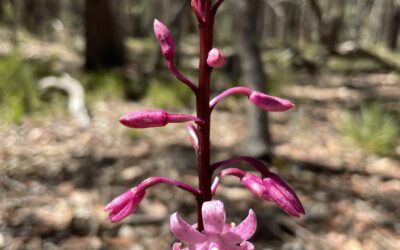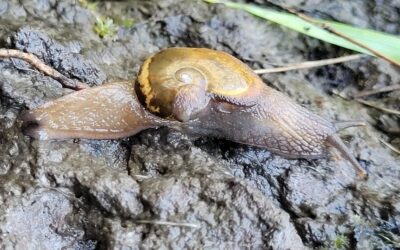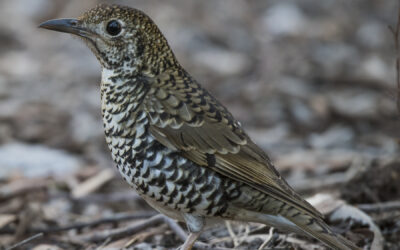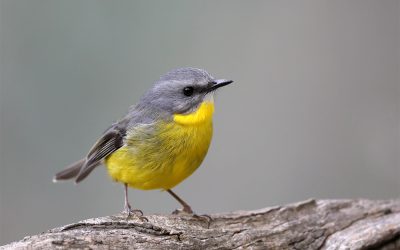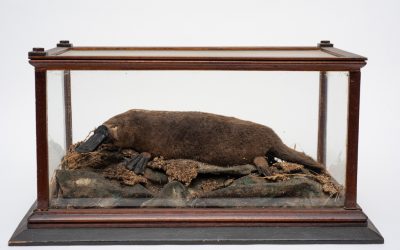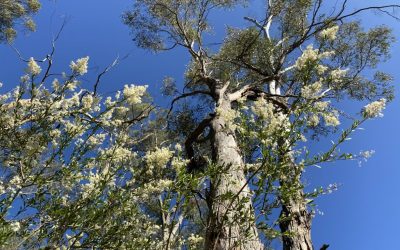Field Naturalist and Nature Writer
Daylesford Nature Diary
Six Seasons in the foothill forests

Praise for Daylesford Nature Diary
“The remarkable Tanya Loos has identified key indicator species for seasonal changes and described them in delightful prose and engaging photographs. Who can resist the appeal of the puggle, an early spring baby echidna indicator?”
Alan Reid, OAM, environmental educator and author of Banksias & Bilbies.
“Attractively produced and well-illustrated… the six seasons and their features are well-described. [The stories] are short and easy to read, covering all sorts of things an observant naturalist might come across: bats, wattles, ghost fungi, mosses, greenhoods, swifts, rosellas, echidnas, wood ducks and many more.”
Roger Thomas, Nature Notes, Ballarat Courier.
“There is much to recommend in this charming and well-written book. The author takes an innovative approach and lays the chapters out according to the seasons of the local Indigenous peoples. The resulting accounts contextualise the wildlife in both space and time that harks back to such seminal natural history classics as eighteenth century naturalist Gilbert White’s The Natural History of Selborne.”
Review in Australian Birdlife magazine. December 2013.
Latest news…
Monthly blog posts describing natural events in the Wombat Forest, ecological explorations, my recent published writings, book reviews and more…
Imperial Jezebels
This year I have been delighted to see Imperial Jezebel butterflies visiting our garden! These large and graceful butterflies are white and edged in black and grey when their wings are open and flat. When they alight on a flower to feed, their wings are held together...
Summer wildflowers
Wildflower season in the foothill forests is an ever-changing parade of colour. The first wave, in early August, is purple hoveas and hardenbergia, offset by yellow wattle blossoms. Then we have a gold and orange pea party as all the ‘egg and bacon’ shrubs and...
Spotting a Spotted Pardalote
These tiny birds are only 9-10 cm in length – about the length of your finger! Spotted Pardalotes are well named, as some of their feathers are covered in white spots. Spotted Pardalotes are usually high in the leaves and branches of gum trees, or eucalypts. Here,...
Daylesford’s Ravens
Have you noticed Daylesford’s resident ravens? These large black glossy birds may be seen perched on various shop signs calling loudly or strutting up and down Vincent Street searching for dropped food. They are Little Ravens – a funny name as they are not little at...
Window frogs!
With all the rain we have been having some lucky locals have spotted 'window frogs' – little groups of frogs clinging to the outside of the window. Kate Tunney, of Mollonghip, took some pics of a few frogs on her phone and posted them online one night a couple of...
Introducing sawflies or spitfires
Spitfires are a well known but somewhat mysterious feature of the Australian bush. What are they? Particularly tough caterpillars? They are actually the young of an insect called a sawfly – which is not a fly at all but a benign relative of wasps. There are about 200...
Snow Gums in the Macedon Ranges: a love story
The first time I really ‘met’ a Snow Gum was not in classic Snow Gum habitat; on top of a mountain in the high country. This Snow Gum was by the Campaspe River, on a private property in Ashbourne, west of Woodend. The landholders had done a capital job of restoring...
Australian King-parrots increasing locally
When people occasionally ask me 'what is my favourite bird?' I am stumped! However, I could say that the parrot family is chock full of favourites! The diminutive but super intelligent Budgerigar. The gentle and endearing Gang-gang Cockatoo. The spirited thug-life...
Local kites hat trick
Our local Square-tailed Kites have done it again - their third successive year of two healthy young kites! Mum and Dad kites must be congratulated for their excellent parenting. The nest is made of lots of thin branches, and set in a forked messmate with four...
A Guide to the Land Snails of Australia
This fabulous little publication could also be called A Guide to the Land Snails, Slugs and Semi-slugs of Australia. And yes – semi-slugs are new to me too! Land snails have a shell that enables the whole animal to tuck itself inside and seal the entrance as a...
Bassian Thrush, Bird Pins and Bird Week
It is National Bird Week and I have already completed one bird count for the Aussie Bird Count. I am aiming for at least one a day! Counting birds is the most wonderful mindfulness practice. When I record the birds I see and hear for twenty minutes my mind is calm and...
Love is in the air for Gang gangs
Love is in the air for our local Gang-gang Cockatoos! Pairs start searching for their breeding hollows in August through to September. The scarlet red of the male’s wispy crest and their stocky grey silhouettes distinguish these loveable cockies from other bird...
Striated Pardalotes in early spring
At this time of year, people are thrilled to see the first signs of early spring – jonquils and the first silver wattles in flower. But for me – it’s the sound of chip chip, chip chip – the arrival of the Striated Pardalotes that give me that spring thrill. Pardalotes...
These La Nińa years have allowed for abundant plant growth and much of our wildlife is thriving. This is a welcome reprieve after the long sad years of the Millenium Drought – and the weird mini droughts we have experienced after that. The adorable creature pictured...
A Phascogale on my street!
I was coming home from work one night, driving slowly along our dirt road when I was thrilled to spot one of the rarer inhabitants of the Wombat Forest and surrounds – the Brush-tailed Phascogale. These small mammals superficially resemble rats – but rats they most...
VicForests now in OUR forest!
Last June, we experienced a wind storm of such ferocity that large swathes of the Wombat Forest were simply flattened. Precious large old growth trees with hollows crashed to the ground, and the forest canopy was rendered unrecognisable in places such as Bullarto. I...
A batty visitor
For some of us, these past couple of months have seen a huge change – back to the office for the first time in two years! Physically getting up and getting to an office (in my case Gisborne) has necessitated some earlier than usual mornings. Last week, I was preparing...
Eastern Yellow Robins are visiting
In late summer and autumn our resident birds here in Porcupine Ridge are joined by a few Eastern Yellow Robins. I only ever see them at the bird bath, at the darker end of dusk, waiting patiently for the thornbills to finish bathing so they can have a quiet drink and...
Native Peas of the Mount Alexander region – book review
In March 2021, I was delighted to bump into Marie Jones, one of the key forces behind Connecting Country – who said “hold on – Bronwyn is on her way.. with the pea book!”. I was very happy to have a chat with Marie and also touch base with Bronwyn Silver,...
On doggies and owls in 2021
With the coronavirus pandemic entering Year Three, it is getting harder to tell what year it is, or indeed what has actually happened! To round off 2021 and get ready for the year ahead I wanted to recap some highlights. It was a big year! First of all anyone who...
Echidnas – ecosystem engineers
In late winter and early spring, Wombat Forest residents may notice an increase in echidna diggings, as on warm north-facing areas the virgin queens of Meat Ants Iridomyrmex are closer to the surface. These queen ants are a rich source of fats, and most welcome for...
Wild Mushrooming: a guide for foragers book review
As we enjoy a long and stunning fungus season in our southeastern Australian forests, a new book called Wild Mushrooming by Alison Pouliot and Tom May has fruited! Local eating and wild foraging are increasing in popularity, and yet until now there have been no books...
Hoot Detective!
The low impressive whoo-hoo of the Powerful Owl, the cheerful boo-book boo-book of the aptly named Southern Boobook - and the strange screech of the Barn Owl are the calls I have been lucky enough to hear around me locally. Now, by listening to short clips from...
Peregrine Falcons – sky hunters
Every four weeks I have a short segment on ABC Ballarat Radio talking birds with presenter Gavin McGrath, and last session was about falcons and other birds of prey. And I realised that after writing nature articles on our local flora and fauna since 2008 - somehow I...
Square-tailed Kites nest locally
One of the very best things about 2020 was the return of Square-tailed Kites nesting in my local area! Friend and brilliant photographer Ambika Bone came out in December with Kaz, an old mate, to photograph the gorgeous rufous coloured fledgelings. We stayed on the...
Reflections: Loos on Platypus
This wonderfully cryptic title is my latest published piece: a reflection on an object in the Castlemaine Art Museum collection - a taxidermied platypus. I really enjoyed researching and writing this article! I have reproduced it here - but to see the original click...
Deep Creek: a visit in Nov – and a bird walk on Jan 9 2021
In late November I visited a couple of landholders in Eganstown - and discovered a new lovely spot! Sue has been getting into permaculture and bee-keeping in a big way, and got in touch wondering if I could visit their property and identify the local eucalypt species....
Gorgeous Gang-gangs
There are some relatively common birds that I find exciting and wondrous to see every single time - Wedge-tailed Eagles, Yellow-tailed Black Cockatoos, Crested Shrike-tits - and of course everyone's favourite stocky grey cockatoo with the whispy little crest- the...
Choo-choo- it’s echidna train time
In the higher altitude foothill forests, the local wattles usually flower in late August and September. The silver wattles are blooming in the Wombat Forest and surrounds: a few weeks early this year. One reliable sign of early spring is right on cue – the appearance...
Looking for lyrebirds ethically in ‘rona times
What is it that makes life worth living? Friends, family, a job well done, creativity expressed. And for me and many of my friends and colleagues it is the pure pure joy of being in nature and experiencing a magic moment. This year has been stressful. I am grateful to...
Fungi and Wallabies
It really is a wonderful fungi season in central Victoria – both the Wombat Forest and drier forests to the north are filled with an ever changing array of spectacular forms. This bounty represents the fruiting bodies of these organisms – and they also provide food...
Close encounter with Tawny
The question I am most frequently asked is “I have found a bird that seems to be hurt – what should I do?” It is always the same answer – capture the bird using a tea towel or towel, and place into an appropriately sized cardboard box. Then pop the box in a quiet room...
Sweet Bursaria in masses of flower
This summer has seen a spectacular flowering of Sweet Bursaria. In mid-January I visited Tipperary Springs and the creekline vegetation was all aglow with creamy white flowers. The air smelt sweet and hummed with the buzzing of flies and bees. Sweet Bursaria is very...
The bushfire crisis: how to help
The internet and social media is awash with hundreds of ways to held wildlife and humans in this bushfire crisis, this time of climate emergency. This post is a summary, while by no means exhaustive, hopefully it will help guide you. I will be adding to it! I have...
Our local stars: daisies
One of my favourite things about early summer is the abundant flowering of a prime patch of Showy Podolepis along the top track of Tipperary Springs.These wonderful native daises are appropriately named for they are indeed very showy! Packed densely along the path,...
Kingfisher returns: kek kek kek!
A Sacred Kingfisher started calling at our bush block today– with a loud and far- carrying ‘kek kek kek kek’! These brilliantly coloured birds are summer visitors to Victoria, and their calls may now be heard in woodlands and open forests throughout Victoria. Although...
The geese saga of Lake Daylesford
This photo shows the Lake Daylesford geese in their new home, a private animal sanctuary in the Mornington Peninsula. Here, the geese have access to five lakes and are able to range freely on the paddocks without having to cross any roads, encounter dog walkers or...
When eagles get frisky
Nature Diary has a new home! After ten years, and increasing frustration with the Advocate, I am now being published in the Local, edited by Donna Kelly. Donna and Kyle have been wonderfully welcoming, and this article about eagles looks just great in this week's...
The globe-trotting fungus lover
This article is printed in Cosmos #83 Alison Pouliot has spent two decades following the fungi. Each year she moves between Australia and her adopted home near Bern, in Switzerland, studying, photographing and marvelling at the fungal hyphae – or mycelium – cycle that...
Chuffed with Choughs
Wheezing, whistling and whining – our two young White-winged Choughs have added to the usual cacophony of their family group this month. Their calls are similar to a young magpie, insistent and oft-repeated, but at a higher pitch. White-winged Choughs are incredibly...
Book review:Journeys to the other side of the world, by Sir David Attenborough
A version of this book review appeared in Issue 81 of Cosmos Magazine Famed for his distinctive narration with hushed tones and restrained awe, David Attenborough is also an accomplished writer, publishing over twenty books since his career began in the 1950s. The...
the brown hare: old big-bum, furze cat
In recent weeks there has been a young hare feeding on grasses just outside our kitchen window. A very young hare is known as a leveret, this fellow or young lady looks to be a subadult. His golden eyes are large and oval and positioned so that he can see danger from...
‘YES’ to the Wombat-Macedon VEAC proposal
The following article is the longer version of the article in the Hepburn Advocate on October 10. The headline given was "Understanding is the key to the future of natural areas" which I thought was nice :)! Recently a number of white and red stencil signs have...
A science journalist is born!
A dramatic title, yes - but it feels that way! Since January this year, I have written a total of 26 articles for Cosmos Magazine! That's between 4-7 per month, and a total of 12, 422 words ( not including the June articles). And whilst continuing my commitment of...
Fine fungi season underway
In May and June, if there is enough rain, our gardens and local bushland are peppered with forms quite strange and wonderful – the sexual apparatus or fruiting bodies of fungi. Fungi are designated their own Kingdom, and their DNA is actually closer to animals than to...
Sociable Skinks on Granite outcrops
For the December Nature News, Tanya Loos from Connecting Country writes about the sociable skinks photographed by Nick Schulz on his property in Nuggetty. Earlier this year, landholder Nick Schulz sent us a series of stunning photographs from a rocky granite outcrop...
Bush peas and friends ablaze in the forest
This year the various pea species in the region are putting on a wonderful show. The Large leaf bush peas in my local forest are covered in huge, healthy looking yellow and orange flowers. The peas are a very important plant group in our local forest – and surpass...
The farmers’ friend – a friend in need
The paddocks near my place in Porcupine Ridge are busy with visitors. Almost a hundred Straw-necked ibis may be seen there each day, first on one paddock then in the other; busy probing the soil with long bills and stalking through the grass tussocks. Straw-necked...





